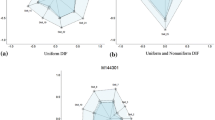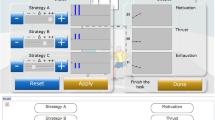Abstract
Process data refer to data recorded in computer-based assessments (CBAs) that reflect respondents’ problem-solving processes and provide greater insight into how respondents solve problems, in addition to how well they solve them. Using the rich information contained in process data, this study proposed an item expansion method to analyze action-level process data from the perspective of diagnostic classification in order to comprehensively understand respondents’ problem-solving competence. The proposed method cannot only estimate respondents’ problem-solving ability along a continuum, but also classify respondents according to their problem-solving skills. To illustrate the application and advantages of the proposed method, a Programme for International Student Assessment (PISA) problem-solving item was used. The results indicated that (a) the estimated latent classes provided more detailed diagnoses of respondents’ problem-solving skills than the observed score categories; (b) although only one item was used, the estimated higher-order latent ability reflected the respondents’ problem-solving ability more accurately than the unidimensional latent ability estimated from the outcome data; and (c) interactions among problem-solving skills followed the conjunctive condensation rule, which indicated that the specific action sequence appeared only when a respondent mastered all required problem solving skills. In conclusion, the proposed diagnostic classification approach is feasible and promising analyzing process data.



Similar content being viewed by others
Notes
More details about this item can be found in https://www.oecd.org/pisa/test-2012/testquestions/question5/ retrieved on July 11th, 2020.
References
Akaike, H. (1981). Likelihood of a model and information criteria. Journal of Econometrics, 16(1), 3–14.
Bock, R. D., & Aitkin, M. (1981). Marginal maximum likelihood estimation of item parameters: Application of an EM algorithm. Psychometrika, 46, 443–459.
Bozdogan, H. (1987). Model selection and Akaike’s information criterion (AIC): The general theory and its analytical extensions. Psychometrika, 52(3), 345–370. https://doi.org/10.1007/BF02294361
Chen, J., de la Torre, J., & Zhang, Z. (2013). Relative and absolute fit evaluation in cognitive diagnosis modeling. Journal of Educational Measurement, 50(2), 123–140.
Chen, Y., Culpepper, S. A., Chen, Y., & Douglas, J. (2018). Bayesian estimation of the DINA Q matrix. Psychometrika, 83(1), 89–108.
Chen, Y., Culpepper, S. A., Wang, S., & Douglas, J. (2018). A hidden Markov model for learning trajectories in cognitive diagnosis with application to spatial rotation skills. Applied Psychological Measurement, 42(1), 5–23.
Chen, Y., Li, X., Liu, J., & Ying, Z. (2017). Recommendation system for adaptive learning. Applied Psychological Measurement, 42(1), 24–41. https://doi.org/10.1177/0146621617697959
Chiu, C.-Y. (2013). Statistical refinement of the Q-matrix in cognitive diagnosis. Applied Psychological Measurement, 37(8), 598–618. https://doi.org/10.1177/0146621613488436
de la Torre, J. (2011). The generalized DINA model framework. Psychometrika, 76(2), 179–199.
de la Torre, J., & Chiu, C.-Y. (2016). A general method of empirical Q-matrix validation. Psychometrika, 81(2), 253–273. https://doi.org/10.1007/s11336-015-9467-8
de la Torre, J., & Douglas, J. (2004). Higher-order latent trait models for cognitive diagnosis. Psychometrika, 69(3), 333–353. https://doi.org/10.1007/BF02295640
de la Torre, J., Hong, Y., & Deng, W. (2010). Factors affecting the item parameter estimation and classification accuracy of the DINA model. Journal of Educational Measurement, 47(2), 227–249.
DiCerbo, K. E., Liu, J., Rutstein, D. W., Choi, Y., & Behrens, J. T. (2011). Visual analysis of sequential log data from complex performance assessments,” [Paper presentation]. In Annual meeting of the American Educational Research Association, New Orleans, LA, USA.
Greiff, S., Niepel, C., Scherer, R., & Martin, R. (2016). Understanding students’ performance in a computer-based assessment of complex problem solving: An analysis of behavioral data from computer-generated log files. Computers in Human Behavior, 61, 36–46. https://doi.org/10.1016/j.chb.2016.02.095
Gu, Y., & Xu, G. (2019). Partial identifiability of restricted latent class models. arXiv preprint arXiv:1803.04353
He, Q., & von Davier, M. (2016). Analyzing process data from problem-solving items with n-grams: Insights from a computer-based large-scale assessment. In Y. Rosen, S. Ferrara, & M. Mosharraf (Eds.), Handbook of research on technology tools for real-world skill development (Vol. 2, pp. 749–776). Hershey: Information Science Reference. https://doi.org/10.4018/978-1-4666-9441-5.ch029
Howard, L., Johnson, J., & Neitzel, C. (2010). Examining learner control in a structured inquiry cycle using process mining. In Proceedings of the 3rd international conference on educational data mining (pp. 71–80). Available online at: https://files.eric.ed.gov/fulltext/ED538834.pdf#page=83 (Accessed August 26, 2018).
Junker, B. W., & Sijtsma, K. (2001). Cognitive assessment models with few assumptions, and connections with nonparametric item response theory. Applied Psychological Measurement, 25(3), 258–272.
Jiao, H., Liao, D., & Zhan, P. (2019). Utilizing process data for cognitive diagnosis. In M. von Davier & Y.-S. Lee (Eds.), Handbook of diagnostic classification models. New York: Springer.
Kroehne, U., & Goldhammer, F. (2018). How to conceptualize, represent, and analyze log data from technology-based assessments? A generic framework and an application to questionnaire items. Behaviormetrika, 45(2), 527–563. https://doi.org/10.1007/s41237-018-0063-y
LaMar, M. M. (2018). Markov decision process measurement model. Psychometrika, 83(1), 67–88. https://doi.org/10.1007/s11336-017-9570-0
Leighton, J. P., Gierl, M. J., & Hunka, S. M. (2004). The attribute hierarchy model: An approach for integrating cognitive theory with assessment practice. Journal of Educational Measurement, 41(3), 205–237. https://doi.org/10.1111/j.1745-3984.2004.tb01163.x
Levy, R. (2014). Dynamic Bayesian network modeling of game based diagnostic assessments (CRESST Report No. 837). Los Angeles, CA: University of California, National Center for Research on Evaluation, Standards, and Student Testing (CRESST), Center for Studies in Education, UCLA. Retrieved August 26, 2018, from https://files.eric.ed.gov/fulltext/ED555714.pdf
Liao, D., He, Q., & Jiao, H. (2019). Mapping background variables with sequential patterns in problem-solving environments: An investigation of us adults’ employment status in PIAAC. Frontiers in Psychology, 10, 646.
Liu, H., Liu, Y., & Li, M. (2018). Analysis of process data of PISA 2012 computer-based problem solving: Application of the modified multilevel mixture IRT model. Frontiers in Psychology, 9, 1372. https://doi.org/10.3389/fpsyg.2018.01372
Liu, J., Xu, G., & Ying, Z. (2012). Data-driven learning of Q-matrix. Applied Psychological Measurement, 36(7), 548–564.
Ma, W., & de la Torre, J. (2020a). Choosing between CDM and unidimensional IRT: The proportional reasoning test case. Measurement Interdisciplinary Research and Perspectives, 18(2), 87–96. https://doi.org/10.1080/15366367.2019.1697122
Ma, W., & de la Torre, J. (2020b). GDINA: An R package for cognitive diagnosis modeling. Journal of Statistical Software, 93(14), 1–26. https://doi.org/10.18637/jss.v093.i14
Maris, E. (1999). Estimating multiple classification latent class models. Psychometrika, 64(2), 187–212.
Masters, G. N. (1982). A Rasch model for partial credit model: Application of an EM algorithm. Applied Psychological Measurement, 16(2), 159–174.
Maydeu-Olivares, A. (2013). Goodness-of-fit assessment of item response theory models. Measurement, 11(3), 71–101.
OECD. (2014). PISA 2012 results: Creative problem solving: Students’ skills in tackling real-life problems (Volume V). PISA, OECD Publishing: https://doi.org/10.1787/9789264208070-en
Qiao, X., & Jiao, H. (2018). Data mining techniques in analyzing process data: A didactic. Frontiers in Psychology, 9, 2231.
Rabiner, L. (1989). A tutorial on hidden Markov models and selected applications in speech recognition. Proceedings of IEEE, 77(2), 257–285.
Ravand, H. (2016). Application of a cognitive diagnostic model to a high-stakes reading comprehension test. Journal of Psychoeducational Assessment, 34(8), 782–799. https://doi.org/10.1177/0734282915623053
Robitzsch, A., Kiefer, T., & Wu, M. (2020). TAM: Test analysis modules. [R package version 3.5-19]. Retrieved from http://CRAN.R-project.org/package=TAM.
Roduta Roberts, M., Alves, C. B., Chu, M.-W., Thompson, M., Bahry, L. M., & Gotzmann, A. (2014). Testing expert-based versus student-based cognitive models for a grade 3 diagnostic mathematics assessment. Applied Measurement in Education, 27(3), 173–195. https://doi.org/10.1080/08957347.2014.905787
Sao Pedro, M. A., Baker, R. S. J. d., & Gobert, J. D. (2012). Improving construct validity yields better models of systematic inquiry, even with less information. In J. Masthoff, B. Mobasher, M. C. Desmarais, & R. Nkambou (Eds.), User modeling, adaptation, and personalization: Proceedings of the 20th UMAP conference (pp. 249–260). Berlin, Germany: Springer.
Schwarz, G. (1978). Estimating the dimension of a model. The Annals of Statistics, 6(2), 461–464.
Sclove, S. L. (1987). Application of model-selection criteria to some problems in multivariate analysis. Psychometrika, 52(3), 333–343. https://doi.org/10.1007/BF02294360
Shu, Z., Bergner, Y., Zhu, M., Hao, J., & von Davier, A. A. (2017). An item response theory analysis of problem-solving processes in scenario-based tasks. Psychological Test and Assessment Modeling, 59(1), 109–131.
Tang, F., & Zhan, P. (2021). Does diagnostic feedback promote learning? Evidence from a longitudinal cognitive diagnostic assessment. AERA Open. https://doi.org/10.13140/RG.2.2.23511.19365
Tang, X., Wang, Z., Liu, J., & Ying, Z. (2020). An exploratory analysis of the latent structure of process data via action sequence autoencoders. British Journal of Mathematical and Statistical Psychology, 74(1), 1–33. https://doi.org/10.1111/bmsp.12203
Tatsuoka, K. K. (1983). Rule-space: An approach for dealing with misconceptions based on item response theory. Journal of Educational Measurement, 20(4), 345–354. https://doi.org/10.1111/j.1745-3984.1983.tb00212.x
Templin, J., & Henson, R. A. (2006). Measurement of psychological disorders using cognitive diagnosis models. Psychological Methods, 11(3), 287–305.
van der Linden, W. J. (2007). A hierarchical framework for modeling speed and accuracy on test items. Psychometrika, 72(3), 287–308. https://doi.org/10.1007/s11336-006-1478-z
von Davier, M., & Lee, Y.-S. (2019). Handbook of diagnostic classification models: Models and model extensions, applications, software packages. Springer.
Wang, S., & Chen, Y. (2020). Using response times and response accuracy to measure fluency within cognitive diagnosis models. Psychometrika, 85, 600–629.
Wang, W., Song, L., Chen, P., Meng, Y., & Ding, S. (2015). Attribute-level and pattern-level classification consistency and accuracy indices for cognitive diagnostic assessment. Journal of Educational Measurement, 52(4), 457–476. https://doi.org/10.1111/jedm.12096.
Wu, H.-M. (2019). Online individualised tutor for improving mathematics learning: A cognitive diagnostic model approach. Educational Psychology, 39(10), 1218–1232. https://doi.org/10.1080/01443410.2018.1494819
Xu, H., Fang, G., & Ying, Z. (2020). A latent topic model with Markovian transition for process data. British Journal of Mathematical and Statistical Psychology. https://doi.org/10.1111/bmsp.12197
Zhan, P. (2020). A Markov estimation strategy for longitudinal learning diagnosis: Providing timely diagnostic feedback. Educational and Psychological Measurement, 80(6), 1145–1167.
Zhan, P., Jiao, H., & Liao, D. (2018). Cognitive diagnosis modelling incorporating item response times. British Journal of Mathematical and Statistical Psychology, 71(2), 262–286.
Zhan, P., Jiao, H., Liao, D., & Li, F. (2019). A longitudinal higher-order diagnostic classification model. Journal of Educational and Behavioral Statistics, 44(3), 251–281.
Zhu, M., Shu, Z., & von Davier, A. A. (2016). Using networks to visualize and analyze process data for educational assessment. Journal of Educational Measurement, 53(2), 190–211.
Funding
This work was supported by the National Natural Science Foundation of China (Grant No. 31900795).
Author information
Authors and Affiliations
Additional information
Publisher's Note
Springer Nature remains neutral with regard to jurisdictional claims in published maps and institutional affiliations.
Peida Zhan and Xin Qiao are co-first authors.
Supplementary Information
Below is the link to the electronic supplementary material.
Rights and permissions
About this article
Cite this article
Zhan, P., Qiao, X. DIAGNOSTIC Classification Analysis of Problem-Solving Competence using Process Data: An Item Expansion Method. Psychometrika 87, 1529–1547 (2022). https://doi.org/10.1007/s11336-022-09855-9
Received:
Revised:
Published:
Issue Date:
DOI: https://doi.org/10.1007/s11336-022-09855-9




